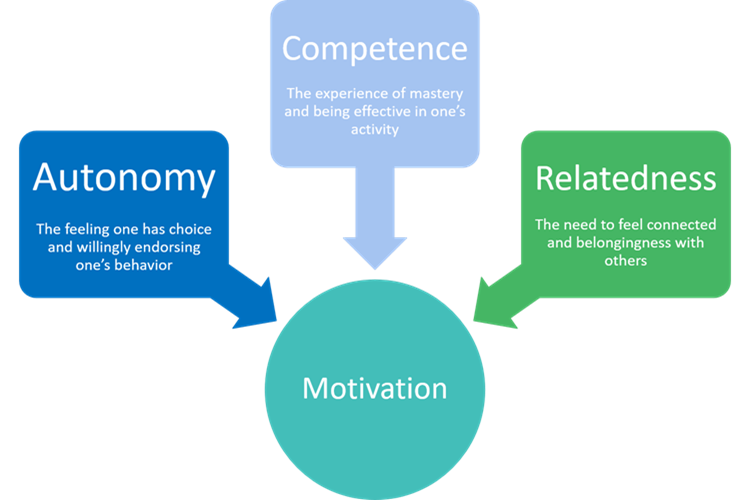2020 Student’s expectations survey conducted by Wonkhe showed that when presented with a scenario of limited face-to-face teaching, 71 per cent said that in such a scenario they would struggle with motivation to learn and keep up interest.
How can we make sure that our students engage with asynchronous online tasks?
Self-determination theory (SDT) by Deci and Ryan (1985, 2002) is one of the most comprehensive and empirically supported theories of motivation available today. Past research indicated that SDT predicts a variety of learning outcomes, including performance, persistence, and course satisfaction (Deci & Ryan, 1985). The SDT-based strategies may apply to a variety of educational settings including online learning environments (Kuan-Chung & Syh-Jong, 2010). According to SDT, when students’ basic psychological needs for autonomy, competence, and relatedness are met, they are more likely to internalize their motivation to learn and be more engaged in their studies.
Source: https://ela-source.com/2019/09/25/self-determination-theory-in-education/
Autonomy
“I prompt students to research a certain idea to bring back to our synchronous class time. I have found that making students responsible for finding content that guides the discussion makes them highly invested.” (Forbes, 2020)
- Maximize students’ perceptions of having a voice and choice in their academic activities.
- Use a survey or discussion board to ask students what they are hoping to get out of the module.
- Make your asynchronous activities flexible, e.g. if you ask them to write a blog post, let students choose the topic.
- Provide students with a meaningful rationale for the usefulness of a learning activity.
- Clearly outline learning outcomes of each activity (or blocks of activities).
Competence
“Students will only engage and personally value activities they can understand and master.” (Kuan-Chung & Syh-Jong, 2010, p.).
- Introduce optimally challenging learning activities, allowing students to test and to expand their academic capabilities.
- Review your syllabus: https://onlineteaching.open.suny.edu/page/reviewsyllabus
- Use Blackboard functions like adaptive release or review status to reinforce the perception of progression and avoid overwhelming students with a large number of activities presented to them at once.
- Provide students with appropriate tools and feedback to promote progress and feelings of efficacy.
- Keep your module structure simple, easy to navigate and consistent.
- Explain how to navigate your module and give them a suggested timeframe for completing activities.
- Communicate with students regularly and be there to answer questions.
- Provide them with informative feedback.
Relatedness
“Research has shown one of the greatest challenges for learning institutions and instructors when designing and implementing online courses is to provide a sense of community with constructive feedback and provide open forthcoming communications” (Boiling, et al., 2011, p.)
- Foster a sense of belonging.
- Use Blackboard tools which facilitate collaboration such as discussion boards or wikis.
- Use reality-based scenarios.
- Link asynchronous online activities to live sessions.
- Show that you like, respect and value your students.
- Create a short video about who you are as a person.
- Be an active member of your module’s online community, respond to students’ comments on discussion forums and wikis.
References:
Boling, E.C., Hough, M., Krinsky, H., Saleem, H., & Stevens, M. (2012). Cutting the distance in distance education: Perspectives on what promotes positive, online learning experiences. The Internet and Higher Education. 15(2), 118-126.
Forbes, L. K. (2020). Fostering Fun: Engaging Students with Asynchronous Online Learning. Retrieved from https://www.facultyfocus.com/articles/online-education/fostering-fun-engaging-students-with-asynchronous-online-learning/
Jackson, A. (2020). The expectation gap: students’ experience of learning during Covid-19 and their expectations for next year. Retrieved from https://wonkhe.com/blogs/the-expectation-gap-students-experience-of-learning-during-covid-19-and-their-expectations-for-next-year/
Kuan-Chung, C. & Syh-Jong, J. (2010). Motivation in online learning: Testing a model of self-determination theory. Computers in Human Behavior. 26(4), 741-752.
Niemiec, C.P. & Ryan, R. M. (2009). Autonomy, competence, and relatedness in the classroom. Applying self-determination theory to educational practice. Theory and Research in Education. 7(2), 133-144.


Pingback: Motivation strategies for online engagement – reflections from the last Academy Forum in Semester One | Learning and Teaching Enhancement Unit
Pingback: Strategaethau er mwyn Ysgogi Ymroddiad i Ddysgu Ar-lein – myfyrdodau o’r Fforwm Academi ddiwethaf yn Semester | Uned Datblygu Dysgu ac Addysgu